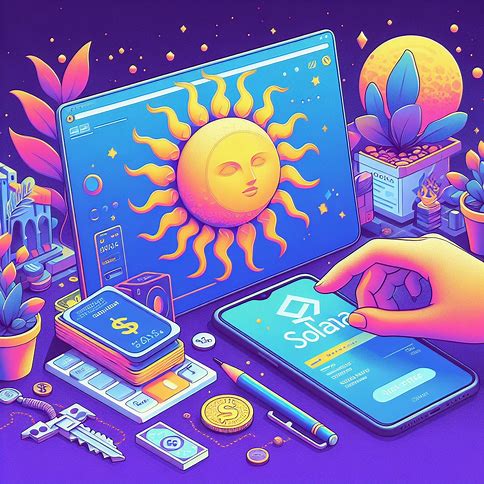Have you been hearing a lot of buzz about Solana lately in the crypto space, but you are not quite sure what it’s all about, we’ll break down exactly what Solana is, how it works, and why so many people in the crypto industry are excited about its potential.
What Is Solana
Solana is a decentralized, open-source blockchain platform designed for scalability and fast transactions. It was founded in 2017 by Anatoly Yakovenko, a former Qualcomm senior staff engineer manager.
What sets Solana apart is its unique hybrid consensus model that combines Proof of Stake (PoS) with Proof of History (PoH). PoS is a common consensus mechanism where validators stake their tokens to participate in transaction validation. PoH, on the other hand, is a cryptographic clock that enables nodes to agree on the ordering of events without needing to communicate constantly. By leveraging PoH alongside PoS, Solana can process transactions much more efficiently.
This hybrid model allows Solana to achieve impressive performance metrics. It claims to support 50,000 transactions per second (TPS) with sub-second confirmation times and low transaction fees, making it one of the fastest blockchains currently available.
Solana is designed to scale horizontally across GPUs and SSDs, meaning its capacity increases as more nodes join the network. This scalability is crucial for enabling widespread adoption of decentralized applications (dApps).
Read Also: What To Do If Your Solana Transaction Is Stuck
The platform’s native cryptocurrency is called SOL. It serves both as a staking token within the PoS system and as a means of paying transaction fees. SOL has seen significant growth since 2021, quickly rising to become one of the top 10 cryptocurrencies by market capitalization.
Solana’s Ecosystem and Use Cases
One of the key factors driving excitement around Solana is its vibrant ecosystem of dApps and projects spanning various sectors, including decentralized finance (DeFi), non-fungible tokens (NFTs), gaming, and more.
In the DeFi space, Solana has attracted major players like Serum, a decentralized exchange (DEX) built by FTX. Serum offers fast, non-custodial trading with an on-chain central limit order book and cross-chain asset swaps. Other notable DeFi projects on Solana include Raydium (an automated market maker), Saber (a cross-chain stablecoin exchange), and Kin (a token used for digital services and payments).
Solana has also made significant strides in the NFT market. Solanart and Metaplex are two of the leading NFT marketplaces on the platform, enabling creators to mint, sell, and trade NFTs with low fees and fast transaction times. The Degenerate Ape Academy collection, launched in mid-August 2021, helped put Solana NFTs on the map, with the entire collection of 10,000 apes selling out in just 8 minutes.
In the realm of gaming, Solana’s high-speed, low-cost transactions make it an attractive blockchain for building play-to-earn games. Projects like Star Atlas (a space exploration game), Aurory (a Japanese RPG-style game), and DeFi Land (a farming simulation game) are all using Solana’s capabilities to create immersive, blockchain-integrated gaming experiences.
Other notable projects in the Solana ecosystem include Audius (a decentralized music streaming platform), Gravity (a decentralized social media protocol), and USDC (one of the leading stablecoins, which is now natively integrated on Solana).
With a wide range of dApps and a strong focus on user experience, Solana is positioning itself as a major player in the blockchain space. Its high-performance capabilities and growing ecosystem have attracted significant attention from developers and investors alike.
The Future of Solana
Solana is well-positioned to play a significant role in shaping the future of decentralized applications and digital assets.
One of the key challenges facing many blockchain platforms today is scalability. As more users and dApps flood into the ecosystem, networks can become congested, leading to slower transaction times and higher fees. Solana’s high-performance architecture and unique consensus mechanism give it a notable advantage in this regard, enabling it to maintain fast speeds and low costs even as adoption grows.
Moreover, Solana’s focus on user experience and developer support bodes well for its long-term prospects. By making it easier for developers to build and deploy dApps, and by prioritizing intuitive interfaces and smooth interactions for end-users, Solana is laying the groundwork for mainstream adoption of blockchain technology.
Of course, the blockchain space is highly competitive, and Solana will need to continue innovating and expanding its ecosystem to stay ahead of the curve. As more institutional investors and traditional companies begin to explore blockchain solutions, Solana’s ability to offer fast, secure, and scalable infrastructure could help it attract major partners and use cases.
Key Takeaways
1. Solana is a high-performance, decentralized blockchain platform designed for scalability and fast transaction speeds.
2. It uses a unique hybrid consensus model combining Proof of Stake (PoS) and Proof of History (PoH) to achieve high throughput and low latency.
3. Solana claims to support 50,000 transactions per second (TPS) with sub-second confirmation times and low transaction fees.
4. The platform’s native cryptocurrency, SOL, serves as both a staking token and a means of paying transaction fees.
5. Solana has a vibrant ecosystem of dApps and projects spanning various sectors, including DeFi, NFTs, gaming, music, and social media.
6. Notable projects in the Solana ecosystem include Serum (DEX), Solanart and Metaplex (NFT marketplaces), Star Atlas and Aurory (games), and Audius (music streaming).
7. Solana’s high-performance capabilities and focus on user experience position it well for mainstream adoption and attracting major partners.
8. The future of Solana looks promising, but it will need to continue innovating and expanding its ecosystem to stay competitive in the rapidly evolving blockchain space.
9. Understanding Solana’s unique features and potential is crucial for developers, investors, and anyone interested in the future of blockchain technology.
Frequently Asked Questions
1. What makes Solana different from other blockchain platforms?
Solana differentiates itself through its high-speed, low-cost transactions enabled by its unique hybrid consensus model combining Proof of Stake (PoS) and Proof of History (PoH). This allows Solana to process up to 50,000 transactions per second (TPS) with sub-second confirmation times.
2. How does Solana achieve such high transaction speeds?
Solana achieves high transaction speeds by using a novel approach called Proof of History (PoH), which creates a cryptographic clock that helps nodes agree on the ordering of events without constant communication. This, combined with Proof of Stake (PoS), enables efficient and fast transaction processing.
3. What is the native cryptocurrency of Solana?
The native cryptocurrency of Solana is called SOL. It serves as a staking token within the PoS system and as a means of paying transaction fees on the network.
4. What kind of applications are built on Solana?
Solana’s ecosystem includes a wide range of decentralized applications (dApps) spanning sectors such as decentralized finance (DeFi), non-fungible tokens (NFTs), gaming, music streaming, and social media.
5. Is Solana secure?
Yes, Solana is designed with security in mind. It uses a combination of Proof of Stake (PoS) and Proof of History (PoH) consensus mechanisms to ensure the integrity and security of transactions on the network.
6. How can I buy SOL, the native token of Solana?
You can buy SOL on various cryptocurrency exchanges, such as Coinbase, Binance, FTX, and Kraken. Make sure to do your own research and only invest what you can afford to lose, as cryptocurrencies can be highly volatile.
7. Can I stake my SOL tokens?
Yes, as a Proof of Stake (PoS) blockchain, Solana allows token holders to stake their SOL tokens to earn rewards and help secure the network. You can stake your SOL directly from a compatible wallet or through a staking service provider.
8. Is Solana open-source?
Yes, Solana is an open-source project. The source code is available on GitHub, and the community is actively encouraged to contribute to the development and improvement of the platform.









